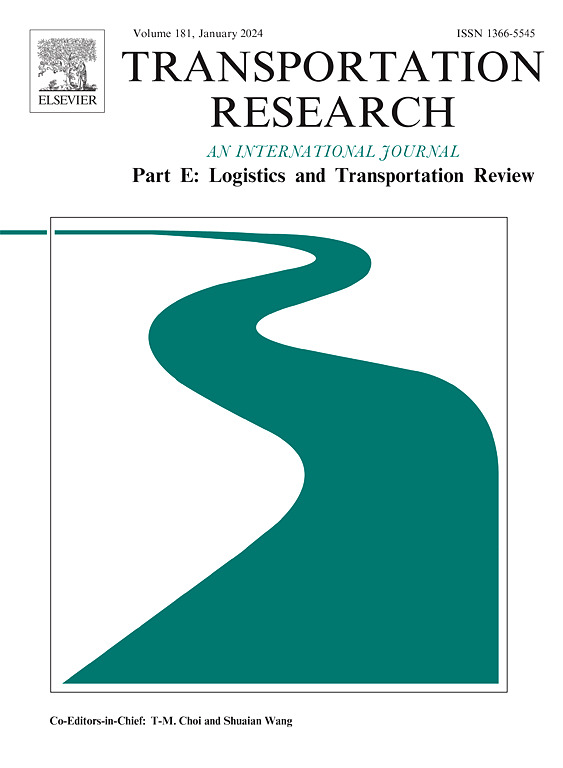Planning of truck platooning for road-network capacitated vehicle routing problem
IF 8.3
1区 工程技术
Q1 ECONOMICS
Transportation Research Part E-Logistics and Transportation Review
Pub Date : 2025-02-01
DOI:10.1016/j.tre.2024.103898
引用次数: 0
Abstract
Truck platooning, a linking technology of trucks on the highway, has gained enormous attention in recent years due to its benefits in energy and operation cost savings. However, most existing studies on truck platooning limit their focus on particular scenarios that each truck can serve only one customer demand and is thus with a specified origin–destination pair, so only routing and time schedules are taken into account. Nevertheless, in real-world logistics, each truck may need to serve multiple customers located at different places, and the operator managing a fleet of trucks thus has to determine not only the routing and time schedules of each truck but also the set of customers allocated to each truck and their sequence to visit. This is well known as a capacitated vehicle routing problem with time windows (CVRPTW), and considering the application of truck platooning in such a problem entails new modeling frameworks and tailored solution algorithms. In light of this, this study makes the first attempt to optimize the truck platooning plan for a road-network CVRPTW in a way to minimize the total operation cost, including vehicles’ fixed dispatch cost and energy cost, while fulfilling all delivery demands within their time window constraints. Specifically, the operation plan will dictate the number of trucks to be dispatched, the set of customers, and the routing and time schedules for each truck. In addition, the modeling framework is constructed based on a road network instead of a traditional customer node graph to better resemble and facilitate the platooning operation. A 3-stage algorithm embedded with a ”route-then-schedule” scheme, Dynamic Programming, and Modified Insertion heuristic, is developed to solve the proposed model in a timely manner. Numerical experiments are conducted to validate the proposed modeling framework, demonstrate the performance of the proposed solution algorithm, and quantify the benefit brought by the truck platooning technology.
路网容能车辆路径问题下的卡车队列规划
卡车队列行驶技术是一种公路上的卡车连接技术,近年来因其在能源和运营成本方面的优势而受到广泛关注。然而,大多数现有的卡车队列研究都局限于每辆卡车只能满足一个客户需求的特定场景,因此具有指定的始发目的地对,因此只考虑了路线和时间表。然而,在现实世界的物流中,每辆卡车可能需要为位于不同地方的多个客户提供服务,因此管理卡车车队的运营商不仅要确定每辆卡车的路线和时间表,还要确定分配给每辆卡车的客户集及其访问顺序。这就是众所周知的带时间窗的有能力车辆路径问题(CVRPTW),考虑卡车队列在这类问题中的应用需要新的建模框架和定制的求解算法。鉴于此,本研究首次尝试对路网CVRPTW的卡车队列调度方案进行优化,使车辆的固定调度成本和能源成本等总运行成本最小,同时在时间窗约束下满足所有交付需求。具体来说,操作计划将规定要派遣的卡车数量、客户集以及每辆卡车的路线和时间表。此外,该建模框架是基于道路网络而不是传统的客户节点图来构建的,以便更好地模拟和方便排队操作。为了及时求解该模型,提出了一种嵌入“先路由后调度”方案、动态规划和修正插入启发式的三阶段算法。通过数值实验验证了所提出的建模框架,验证了所提出的求解算法的性能,并量化了卡车队列技术带来的效益。
本文章由计算机程序翻译,如有差异,请以英文原文为准。
求助全文
约1分钟内获得全文
求助全文
来源期刊
CiteScore
16.20
自引率
16.00%
发文量
285
审稿时长
62 days
期刊介绍:
Transportation Research Part E: Logistics and Transportation Review is a reputable journal that publishes high-quality articles covering a wide range of topics in the field of logistics and transportation research. The journal welcomes submissions on various subjects, including transport economics, transport infrastructure and investment appraisal, evaluation of public policies related to transportation, empirical and analytical studies of logistics management practices and performance, logistics and operations models, and logistics and supply chain management.
Part E aims to provide informative and well-researched articles that contribute to the understanding and advancement of the field. The content of the journal is complementary to other prestigious journals in transportation research, such as Transportation Research Part A: Policy and Practice, Part B: Methodological, Part C: Emerging Technologies, Part D: Transport and Environment, and Part F: Traffic Psychology and Behaviour. Together, these journals form a comprehensive and cohesive reference for current research in transportation science.

 求助内容:
求助内容: 应助结果提醒方式:
应助结果提醒方式:


